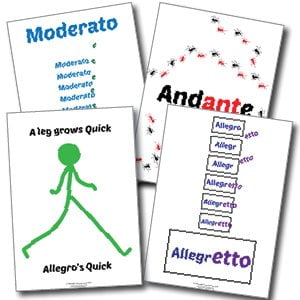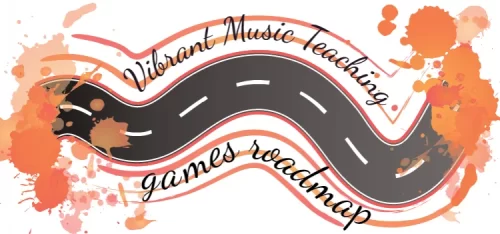When do you introduce a new music theory concept to a student? Do you wait until it comes along in their method book or other repertoire? Do you follow a certain curriculum? Maybe you even just “wing it”? If so, just wait until you see how powerful the idea of teaching “preemptive music theory” can be for your students.

⬆️ Listen to the podcast above or keep on reading, whichever fits your style. ↙️
Preemptive theory is a term I just made up, so don’t worry if you haven’t heard about it. 😜 It’s just a way to describe how I like to approach music theory with my students.
But before we dive into that, let’s look at the standard way of teaching new music theory ideas.
The All-At-Once Approach
The standard way to approach theory in music lessons is to introduce a new term, symbol or concept as and when it comes up in a piece a student is learning.
This just-in-time learning makes a certain kind of sense. After all, the student will be able to put the new concept into action right away and it will feel directly relevant to the music they want to learn.
This logic does follow with learning other skills. For example, I don’t see any point in learning everything about a certain software and all its menus right away when you start using it. I think it’s almost always better to have the motivation or need to do something with the software, and then find out how to go about doing it as you go along.
But this starts to fall apart when you consider how much newness there is in most new music concepts.
If we introduce staccato to a student and then immediately ask them to play a piece of music with staccato notes, we’re asking them to:
- Recognise the symbol
- Learn the new term “staccato”
- Perform the physical action needed for this articulation
- All while reading a brand new piece of music which is probably still challenging for them if they’re only at the level of learning about staccato!
It’s a lot. And, on top of that, music tends to come with a tendency towards perfectionism from many people.
Kids and adults alike get more easily frustrated with themselves when they play wrong notes than when they click on the wrong thing and have to undo work on a computer. Music just has a certain weightiness that other new skills don’t.
To allow for smoother sailing, less self-recrimination and more fun all around, I like to preempt the written music with the theory rather than letting it all happen at once.
P.S. If you love the idea of preemptive theory, these “Tempo Trick” posters will definitely come in handy when it’s time to introduce new tempo terms to a student.

Subscribe to updates and get the tempo trick posters.
Enter your details to subscribe to the newsletter for piano teachers with information, tips and offers.
I hate spam as much as you do! I’ll only send you information that’s directly relevant to music teachers and you can unsubscribe at any time.
VMT members can access the posters immediately in the members-only printable library. Not a member? Learn more at vibrantmusicteaching.com.
Preemptive Music Theory
The idea of teaching preemptive music theory is simple:
Students should meet a concept/symbol/term away from the piano before they are asked to play a piece that uses it.
My goal is that students are introduced to a concept for the first time about 2 – 8 weeks before the method book has the little info box about it or it comes up in their general repertoire.
For most things, 2 weeks out is great. The longer time frame is especially useful for things that are more complex or have many new elements grouped together, like the grand staff, intervals (initially 2nds and 3rds), landmark notes etc.
Wait, what about sound-before-symbol?
You may think I’m putting the cart before the horse here.
You might agree that introducing the symbol, term, action and reading pieces all at the same time isn’t the right way to go about things…but perhaps you think that I’ve chosen the wrong thing to preempt.
But I’m actually not contradicting the sound-before-symbol approach.
I think we should do that, too.
The ideal lesson-planning scenario for me goes something like:
- Months before meeting a musical concept, the student hears it and moves to it and discusses it in their own words.
- Weeks before seeing a concept in a written piece, the student improvises using that articulation, sound or technique.
- Also weeks before seeing it on the page, the student plays a game or does a manipulative-based activity to see the new symbol, term or concept.
- The student gets to a written piece that uses it and greets it as a friend as they embed it in the world of music reading.
Does everything always map out this perfectly tickety boo?
NO.
Of course not. We teach humans, not automatons. And we are not (nor should we try to be!) perfect, either.
But having an ideal scenario in mind can help shape the general trajectory students move through. Doing this with even some concepts, or doing some of this with most concepts, can go a long way.
Preemptive Music Theory Planning
Speaking of humans vs robots, you’re probably wondering how on earth you’re going to plan for this along with everything else you do.
Roadmaps for Preemptive Music Theory
One simple solution is to just use the Vibrant Music Teaching roadmaps. We have these set up for Piano Safari, Piano Adventures and Piano Pronto. If you use one of those methods, all you need to do is look ahead of where your student is currently in their method book and play the games listed.
Even if these roadmaps don’t cover your whole studio, it would be a great start and get you used to working this way.
Creating Your Own Preemptive Music Theory Plans
If you’re not a member of Vibrant Music Teaching or you don’t use any of those methods, you’ll have to make your own roadmap. The trick with all changes like this is to take one step at a time.
- Start with one student who is in a method book at the moment. (Method books are the simplest place to start, as you always know ahead of time what pieces they’ll be doing.)
- Look 3 pieces ahead from where they are right now, and find where a new concept is introduced.
- Find an activity or game to teach them that concept now.
Once you get started, your brain will start working this way over time. Pretty soon, you won’t even need to think about it.

Do you believe in preemptive music theory?
What struggles do you have with teaching preemptive music theory, or what qualms do you have about the idea? Let’s start a debate and a brainstorm in the comments below.
For more ideas like this, visit my Planning Lessons hub page for the latest-and-greatest resources!
